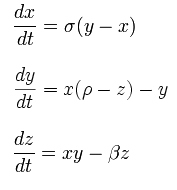Strange Attractors
We are now entering perhaps the most abstract chapter in this course. Strange attractors are useful ways to describe the behavior of complex systems, but they require a little...
stretching of your mind. Furthermore, they are often generated by calculating differential equations, part of the study of Calculus, which we will glimpse here but not
delve into deeply.
The basic concept of a simple attractor is that it is the solution or pattern of behavior that a system reaches. It is a way of visualizing the outcome
of a system for any given starting values. To give a simple example, imagine a pendulum. If you pull it off to the side (the starting condition) and release it, the pendulum will
swing back and forth slowing down until it reaches the fixed point in the middle and stops. This is the simple attractor for the system.
The Lorenz Attractor
The first example of a strange attractor we will encounter is the Lorenz Attractor, the most famous of these entities. It shows the behavior of a point following the
Lorenz equations, which were derived to predict the weather.

This infinitely complex object is created by repeatedly calculating the following 'simple' equations:
These are the equations Lorenz used to simulate the motion of air in the atmosphere that led him to discover the phenomenon of sensitivity to initial conditions,
the butterfly Effect, and the whole field of chaos theory. These are differential equations, which we will not explain here in detail, except to note that the term
dx/dt refers to the rate of change of the variable x as a function of time. So these three equations describe how the rate of change of the variables x,y, and z depends
on the state of the variables. While this is not a trivial system to solve, we show them here to illustrate how simple and concise a system of equations can be that gives rise to such
complex patterns.
Now we'll use the Lorenz Attractor to illustrate the Butterfly Effect. Click somewhere in the rectangle below to start the Lorenz applet. Watch for a while as the
point traces a path around the attractor. Notice how it never quite retraces its path.
Hit the 'clear' button to erase the trace. Now click in the applet to launch a trace, and then click again, very close to the first point to launch a second trace. They may follow each other for a little while,
but eventually the two traces will diverge and take on totally different values.
Click somewhere else in the applet, far away from the first two starting points. Even though the starting points are very different, they are both attracted
to the same basic pathway, tracing out the attractor. Click as many times as you like, to see a variety of starting points drawn into the amazing Lorenz attractor.
|
|||
|
<- PREVIOUS NEXT -> © Fractal Foundation. |

